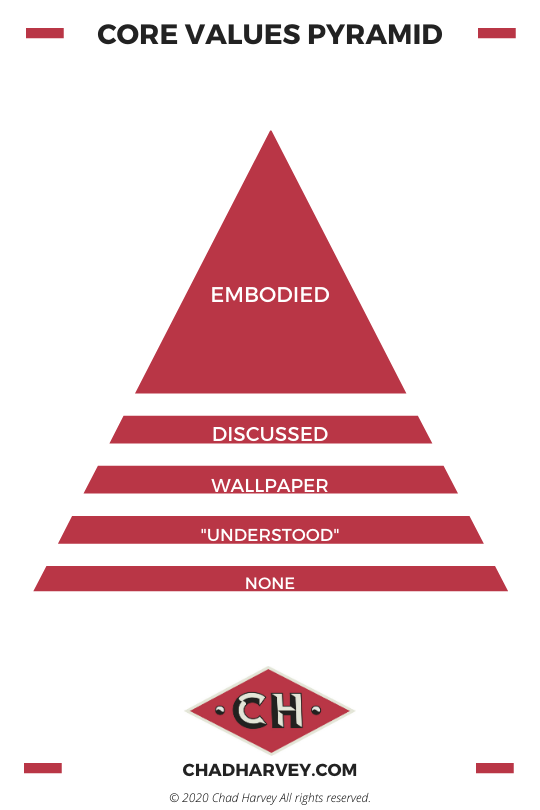A Tool for Assessing Your Organization’s Core Values

“I’d like to be part of an organization where anything goes, no one knows what we stand for, and employees are subject to an ever-changing set of unwritten rules,” said no one ever. Yet this is exactly how many organizations handle their values (or the lack thereof).
While the above statement may seem extreme, it’s very real and the reason why many leaders struggle with their Mission, Vision, and Purpose. They haven’t evaluated their organization’s values or put in the hard work to establish, codify, and implement core values. Fortunately, there’s a handy way to assess the state of your values—the Core Values Pyramid.
The Core Values Pyramid
Let’s take a moment to break down the Pyramid and explore each level from the bottom up.
None
There’s a fine line between not having organizational values and entering the Pyramid’s next level of “Understood.” Generally, though, this lowest level is self-explanatory. Organizations that haven’t established core values find themselves in this unfortunate position. Often, leadership has not even realized that they don’t have core values, nor have they considered the need for their existence. In short, there is a total lack of core values and no thought about their worth.
“Understood”
The second level of the Core Values Pyramid is an interesting one. It’s often where smaller middle-market organizations land—typically owner-operated or family-owned businesses. At the “Understood” level, the organization’s values are unwritten and floating around in the leader’s head. The leader assumes that everyone “understands” the values. Leaders whose organizations are at the “Understood” level may make statements like the following when asked about their core values:
- “My [insert relative: e.g., father, grandmother, etc.] founded this organization, and we’ve stood for the same thing this whole time.”
- “This organization has been around for “X years,” and everyone knows our values.”
- “I lead by example, and everyone knows what we stand for.”
- “We only hire quality employees who embody our values.”
- “Our customers know what we stand for.”
If any of the above statements sound familiar and no written set of core values exists, then you’re at the “Understood” level.
Wallpaper
The “Wallpaper” level of the Core Values Pyramid is where organizational leaders have “checked a box” and moved on. It can often bleed into the “Discussed” level but generally is characterized by a lack of active conversation about the organization’s core values. Here is how this level most often appears:
- Core values are written and posted throughout the organization, but no one ever discusses or references them.
- The organization’s leader created the values without input from anyone else.
- The values are designed primarily with the organization’s clients or customers in mind (and not employees or other stakeholders).
- The values are either single words or simple phrases with no clarifying statements or sample behaviors.
- When asked about the organization’s core values, almost no one can remember them without a cheat sheet.
Discussed
The “Discussed” level of the Core Values Pyramid is where values implementation starts to get real. It’s also, unfortunately, where many organizations become stuck. At this level, leaders publish and tout their organization’s values but have not driven them through all levels of the organization. Here are a few indicators that you’re at the “Discussed” level:
- The leadership team knows and understands the core values, but middle- and line-level management have only partly adopted and internalized them.
- Core values are published and referenced at meetings but otherwise don’t play a role in the organization’s daily business.
- When asked, employees feel that the organization either ignores or references these core values when it suits them and generally applies them inconsistently.
- Core values may be referenced (or used as a rationale) when terminating employees but rarely used to screen applicants during an interview nor mentioned during the hiring process.
Embodied
The “Embodied” level of the Core Values Pyramid is where your organization is firing on all cylinders. Everyone from line-level employees to the CEO understands the core values and knows how to apply them. This is a fantastic position to be in, yet it’s also precarious as you’ve earned employees’ trust, and now you have to keep it. An organization with embodied values might look like this:
- All employees know the core values and understand them. They might even have a personal favorite or have identified one or two values that are most relevant to their daily work.
- Values are discussed constantly and referenced at all organizational levels.
- A straight line can be drawn from your core values to the organization’s strategy and tactics.
- Courage is displayed by leadership and management in the form of choices and decisions that reinforce the values.
- Values are applied both internally and externally to all stakeholders.
Where Does Your Organization Stand?
I’ve found that considering the five levels of the Core Values Pyramid is an effective way to determine where an organization currently stands. If you’re struggling to figure out which level you occupy now, how to get to the next one, or ways to manage the challenges of your current level, please give me a call. I’m always up for a good conversation about core values.

